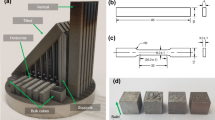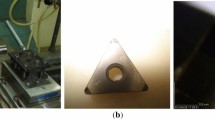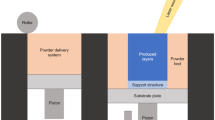Abstract
This study investigates the relationship between residual stresses, cutting parameters, and machining performance in the milling process of compacted graphite iron (CGI). X-ray diffraction (XRD) analysis is employed to measure residual stresses on the cast and milled surfaces, while cutting force modeling is utilized to calculate the tangential force, power, and active work. The results demonstrate that tensile residual stresses are predominant on the milled surfaces, attributed to the both mechanical and thermal loads generated during milling. By analyzing various cutting conditions, it is observed that lower feeds contribute to reduced plastic deformation, resulting in lower residual stress levels. Additionally, higher cutting speeds lead to higher temperatures, but due to the shorter machining time, heat accumulation is limited, resulting in higher residual stresses, especially at low feeds. At high feeds, residual stresses decreased as the cutting speed increased. The interplay between cutting parameters and residual stresses highlights the need for optimizing cutting conditions to enhance fatigue strength in CGI components. These findings provide valuable insights for process optimization and quality control in the milling of CGI materials.



Source: M.E. Fitzpatrick, A.T. Fry, P. Holdway, F.A. Kandil, J. Shackleton, and L. Suominen, Determination of Residual Stresses by x-ray Diffraction —Issue 2, NPL, 2005

Source: M.E. Fitzpatrick, A.T. Fry, P. Holdway, F.A. Kandil, J. Shackleton, and L. Suominen, Determination of Residual Stresses by x-ray Diffraction—Issue 2, NPL, 2005





Similar content being viewed by others
References
E.C. Reed and J.A. Viens, The Influence of Surface Residual Stress on Fatigue Limit of Titanium, ASME. J. Eng. Ind., 1960, 82(1), p 76–78. https://doi.org/10.1115/1.3663004
F. Mocellin, E. Melleras, W.L. Guesser, and L. Boehs, Study of the Machinability of Compacted Graphite Iron for Drilling Process, J. Braz. Soc. Mech. Sci. Eng., 2004, 26(1), p 22–27. https://doi.org/10.1590/S1678-58782004000100004
M.E. Turan, S. Ozcelik, F. Husem, H. Ahlatci, Y. Sun, and I. Tozlu, The Effect of Head Hardening Process on the Residual Stress of Rails, Proc. I. Mech. Eng. Part F J. Rail Rapid Transit, 2018, 232(2), p 589–595. https://doi.org/10.1177/0954409716679450
P.J. Withers, M. Turski, L. Edwards, P.J. Bouchard, and D.J. Buttle, Recent Advances in Residual Stress Measurement, Int. J. Press. Vessel. Pip., 2008, 85(3), p 118–127. https://doi.org/10.1016/j.ijpvp.2007.10.007
S.B. Dronavalli, Residual Stress Measurements and Analysis by Destructive and Non-Destructive Techniques, University of Nevada, Reno, 2004.
K.H. Salman, A.H. Elsheikh, M. Ashham, M.K.A. Ali, M. Rashad, and Z. Haiou, Effect of Cutting Parameters on Surface Residual Stresses in Dry Turning of AISI 1035 Alloy, J. Braz. Soc. Mech. Sci. Eng., 2019, 41, p 349. https://doi.org/10.1007/s40430-019-1846-0
A.H. Elsheikh, S. Shanmugan, T. Muthuramalingam, A.K. Thakur, F.A. Essa, A.M.M. Ibrahim, and O.M. Mosleh, A Comprehensive Review on Residual Stresses in Turning, Adv. Manuf., 2022, 10, p 287–312. https://doi.org/10.1007/s40436-021-00371-0
M. Girinon, F. Dumont, F. Valiorgue, J. Rech, E. Feulvarch, F. Lefebvre, H. Karaouni, and E. Jourden, Influence of Lubrication Modes on Residual Stresses Generation in Drilling of 316L, 15-5PH and Inconel 718 Alloys, Procedia CIRP, 2018, 71, p 41–46. https://doi.org/10.1016/j.procir.2018.05.020
A. Rasti, M.H. Sadeghi, and S.S. Farshi, An Analytical Study on Residual Stresses in Drilling of Hardened Steel, Int. J. Adv. Manuf. Technol., 2018, 99, p 2389–2405. https://doi.org/10.1007/s00170-018-2587-4
O. Karabelchtchikova and I.V. Rivero, Variability of Residual Stresses and Superposition Effect in Multipass Grinding of High-Carbon High-Chromium Steel, J. Mater. Eng. Perform., 2005, 14, p 50–60. https://doi.org/10.1361/10599490522266
M. Soori and B. Arezoo, Minimization of Surface Roughness and Residual Stress in Grinding Operations of Inconel 718, J. Mater. Eng. Perform., 2022, 32, p 8185–8194. https://doi.org/10.1007/s11665-022-07721-4
B. Khosrozadeh and M. Shabgard, Effects of Hybrid Electrical Discharge Machining Processes on Surface Integrity and Residual Stresses of Ti-6Al-4V Titanium Alloy, Int. J. Adv. Manuf. Technol., 2017, 93, p 1999–2011. https://doi.org/10.1007/s00170-017-0601-x
L.V. Colwell, M.J. Sinnott, and J.C. Tobin, The Determination of Residual Stresses in Hardened, Ground Steel, Trans. Am. Soc. Mech. Eng., 1955, 77(7), p 1099–1104. https://doi.org/10.1115/1.4014606
Q. Wu, D.P. Li, and Y.D. Zhang, Detecting Milling Deformation in 7075 Aluminum Alloy Aeronautical Monolithic Components Using the Quasi-Symmetric Machining Method, Metals, 2016, 6(4), p 80. https://doi.org/10.3390/met6040080
A. Berglund, Criteria for Machinability Evaluation of Compacted Graphite Iron Materials. Ph.D. Thesis, KTH Royal Institute of Technology (2011). Available from http://urn.kb.se/resolve?urn=urn:nbn:se:kth:diva-48430
W.H. Bragg and W.L. Bragg, The Reflection of x-rays by Crystals, Proc. R. Soc. Lond. Ser. A Contain. Pap. Math. Phys. Charact., 1913, 88(605), p 428–438. https://doi.org/10.1098/rspa.1913.0040
C.S. Barrett and T.B. Massalski, Structure of Metals, Pergamon Press, Oxford, 1981.
M.E. Fitzpatrick, A.T. Fry, P. Holdway, F.A. Kandil, J. Shackleton, and L. Suominen, Determination of Residual Stresses by x-ray Diffraction—Issue 2, NPL, Teddington, 2005.
I.C. Noyan and J.B. Cohen, Residual Stress: Measurement by Diffraction and Interpretation, Materials Research and Engineering, 1987th ed. Springer, New York, NY, 2012.
H.H. Lester and R.M. Aborn, Behaviour under Stress of Iron Crystal in Steel, Army Ordnance, 1925, 6(6), p 120–127.
J784A_197108, Ground Vehicle Standard, Residual Stress Measurement by x-ray Diffraction, SAE International, Warrendale, 1971.
ISO 16112:2017, Compacted (vermicular) Graphite Cast Irons—Classification
A.L. Mantle and D.K. Aspinwall, Surface Integrity of a High Speed Milled Gamma Titanium Aluminide, J. Mater. Process. Technol., 2001, 118, p 143–150. https://doi.org/10.1016/S0924-0136(01)00914-1
X. Huang, J. Sun, J. Li, X. Han, and Q. Xiong, An Experimental Investigation of Residual Stresses in High-Speed End Milling 7050-T7451 Aluminum Alloy, Adv. Mech. Eng., 2013, 5, p 1–7. https://doi.org/10.1155/2013/592659
D. Hioki, A.E. Diniz, and A. Sinatora, Influence of HSM Cutting Parameters on the Surface Integrity Characteristics of Hardened AISI H13 Steel, J. Braz. Soc. Mech. Sci., 2013, 35, p 537–553. https://doi.org/10.1007/s40430-013-0050-x
B.R. Sridhar, G. Devananda, K. Ramachandra, and R. Bhat, Effect of Machining Parameters and Heat Treatment on the Residual Stress Distribution in Titanium Alloy IMI-834, J. Mater. Process. Technol., 2003, 139, p 628–634. https://doi.org/10.1016/s0924-0136(03)00612-5
M. Salahshoor and Y.B. Guo, Surface Integrity of Biodegradable Orthopedic Magnesium–Calcium Alloy by High-Speed Dry Face Milling, Prod. Eng., 2011, 5, p 641–650. https://doi.org/10.1007/s11740-011-0341-y
I. Ullah, S. Zhang and S. Waqar, Numerical and Experimental Investigation on Thermo-mechanically Induced Residual Stress in High-Speed Milling of Ti-6Al-4V Alloy, J. Manuf. Process., 2022, 76, p 575–587. https://doi.org/10.1016/j.jmapro.2022.02.039
M.L. Silveira, D.A. de Oliveira, A. dos Santos, P.E. de Faria, and A.M. Abrao, Assessment of the Surface Integrity of AISI H13 Tool Steel After Milling with Carbide and Cermet Inserts, Int. J. Adv. Manuf. Technol., 2023, 125, p 3135–3148. https://doi.org/10.1007/s00170-023-10843-1
J.Y. Xu, Q.L. An, and M. Chen, Analysis on Milling Performance of 2024-T351 Aluminum Alloy Using TiAlN Coated Carbide Cutting Tools, Mater. Sci. Forum, 2011, 697–698, p 218–222. https://doi.org/10.4028/www.scientific.net/MSF.697-698.218
J. Sun and Y.B. Guo, A Comprehensive Experimental Study on Surface Integrity by End Milling Ti-6Al-4V, J. Mater. Process. Technol., 2009, 209, p 4036–4042. https://doi.org/10.1016/j.jmatprotec.2008.09.022
Q. Wu, D.J. Xie, Y. Si, Y.D. Zhang, L. Li, and Y.X. Zhao, Simulation Analysis and Experimental Study of Milling Surface Residual Stress of Ti-10V-2Fe-3Al, J. Manuf. Process., 2018, 32, p 530–537. https://doi.org/10.1016/j.jmapro.2018.03.015
M.K. Prakash, K.C.S. Chethan, and P.H.P. Thirtha, Residual Stresses Modelling of End Milling Process Using Numerical and Experimental Methods, Mater. Sci. Forum, 2020, 978, p 106–113. https://doi.org/10.4028/www.scientific.net/MSF.978.106
M.E. Kara, A.T. Kuzu, and M. Bakkal, The Development of a Hybrid Cutting Model for Workpiece Temperature Distribution via Advection Heat Partition Approach, Int. J. Adv. Manuf. Technol., 2023, 126, p 4283–4295. https://doi.org/10.1007/s00170-023-11393-2
B. Griffiths, Manufacturing Surface Technology: Surface Integrity & Functional Performance, CRC Press, Boca Raton, 2001.
K. Okushima and Y. Kakino, A Study on the Residual Stress Produced by Metal Cutting, Mem. Fac. Eng. Kyoto Univ., 1972, 34(2), p 234–248.
Acknowledgments
We are thankful for the support received from The Scientific and Technological Research Council of Türkiye.
Author information
Authors and Affiliations
Corresponding author
Ethics declarations
Conflict of interest
The authors declare no competing interests.
Additional information
Publisher's Note
Springer Nature remains neutral with regard to jurisdictional claims in published maps and institutional affiliations.
This invited article is part of a special topical issue of the Journal of Materials Engineering and Performance on Residual Stress Analysis: Measurement, Effects, and Control. The issue was organized by Rajan Bhambroo, Tenneco, Inc.; Lesley Frame, University of Connecticut; Andrew Payzant, Oak Ridge National Laboratory; and James Pineault, Proto Manufacturing on behalf of the ASM Residual Stress Technical Committee.
Rights and permissions
Springer Nature or its licensor (e.g. a society or other partner) holds exclusive rights to this article under a publishing agreement with the author(s) or other rightsholder(s); author self-archiving of the accepted manuscript version of this article is solely governed by the terms of such publishing agreement and applicable law.
About this article
Cite this article
Kara, M.E., Kuzu, A.T. & Bakkal, M. Investigation of Residual Stresses Induced by Milling of Compacted Graphite Iron by x-ray Diffraction Technique. J. of Materi Eng and Perform 33, 3801–3810 (2024). https://doi.org/10.1007/s11665-023-08904-3
Received:
Revised:
Accepted:
Published:
Issue Date:
DOI: https://doi.org/10.1007/s11665-023-08904-3




